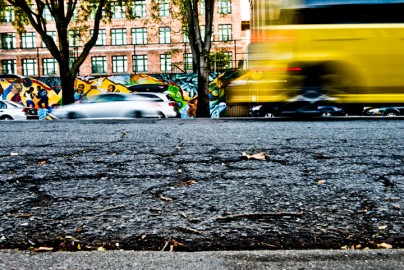Potholes are more than just annoying

By Alex Reyes
Driving on Van Ness Avenue toward Eddy Street and Civic Center campus, the City College student must be ever vigilant to avoid the depressions, divots, potholes and sewer work that can wreak havoc on a car’s tires and underbody.
The intersection of Van Ness and Eddy is exhibit A of all of the above except potholes.
The five driving lanes of Hayes Street near the John Adams campus are so battered by traffic that a complete redo is in order.
The block of Hayes in front of John Adams is equally worn. A patch of busted-up asphalt in front of the 21 Hayes bus stop looks particularly decrepit.
San Francisco’s deteriorated street infrastructure is not unique. Such threats to American safety exist nationwide.
Take our nation’s bridges, for instance.
In his 2013 State of the Union address, President Barack Obama proposed a “Fix-It-First” program to make “our most urgent repairs, like the nearly 70,000 structurally deficient bridges across the country.”
Pause and think about all the implications of this statement. Nearly 70,000 bridges from sea to shining sea are possible threats to the public safety?
Turns out that “we, the people” have known about this and other national infrastructure deficiencies for too many years. In 1998, the federal Department of Transportation determined there were 93,072 structurally deficient bridges. 79,500 were called “structurally obsolete.”
And it also turns out that a National Infrastructure Reinvestment Bank has been proposed in Washington since 2007, at the latest.
In February 2008, then-Senator Obama began to publicly support the infrastructure bank project first proposed by former Senators Chris Dodd and Chuck Hagel (the latter is now the Secretary the Defense).
Obama is now pushing a national infrastructure plan again, not just for bridge repairs, but for an evolutionary upgrade of our country’s infrastructure old and new.
Of course, as worthy an idea as the above sounds, its passage is being held hostage by the Republican majority in the House of Representatives.
Speaker of the House John Boehner is now using his bully pulpit to state publicly that federal income tax reform is “stealing people’s money.”
(Isn’t Boehner the same Speaker who supported federal income tax reform four months ago?)
If a civilized society is truly concerned about promoting “the General welfare,” as the preamble to the Constitution defines such matters, would it allow its people to drive over 70,000 bridges which present a hazard to our health?
I’m guessing not. I’m guessing a civilized society truly concerned about its own welfare would fund at all times an adequate infrastructure maintenance force.
On Feb. 27, BusinessInsider.com published “17 major US bridges that need to be fixed right away.” Interstate Highway 25, over the Platte River near Denver, Colo., scored 24.5 out of 100 on the Federal Highway Administration’s sufficiency rating.
Other such low sufficiency bridges are I-95 State Route 745 in New Haven, Conn., the I-278 approach to the Verrazano Bridge in Staten Island, N.Y. and the I-10 110th Avenue bridge in Los Angeles.
So we live in a society in which the norm includes tens of thousands of hazardous bridges and who-knows-how-many miles of hazardous streets (not to mention lives that can be taken away at any time due to a saturation of civilian and military weaponry).
We Americans show a studied disregard for our own individual and collective well-being. Being this rough on ourselves, it’s no wonder how we’ve treated others.

Comments are closed.